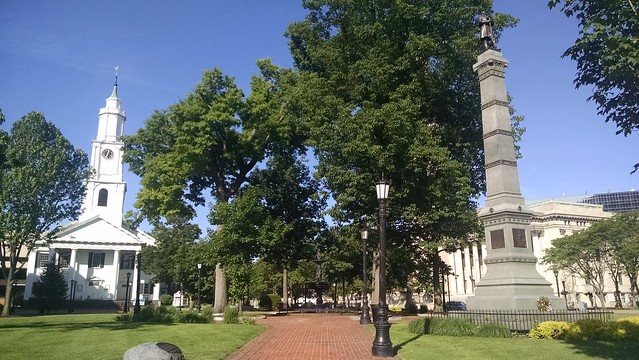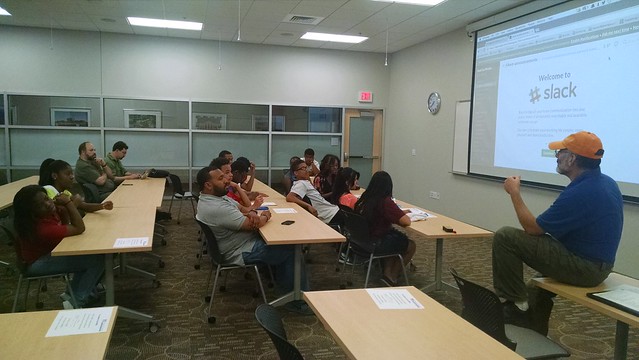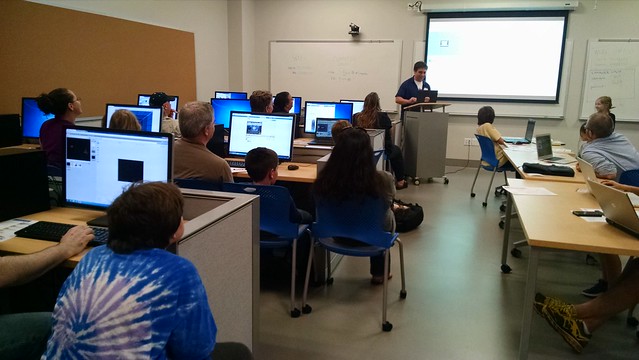Hack for Western Mass: Day Two
Day two got off to a slightly rough start when we realized that, although we had a plan for breakfast, no-one had connected the dots to order it or pick it up. Cristos made the command decision to just go get it. So, although it was a few minutes late, we had plenty of coffee and tasty things for people to eat.
Everyone quickly settled back into work and, other than a gentle reminder as the morning wore-on to shift from working on the project to working on a presentation, the organizers could take a break and catch up on other things (like writing the Day One summary. :-)
Toward 11:30 brunch arrived and shortly after noon, the final presentations commenced. There was a flurry of live-tweeting as the events happened.
We are pleased to confirm that we've managed to tweet almost as often as we intended this weekend. #h4wma
— Valley Nerd Watch (@ValleyNerdWatch) June 7, 2015
I was pleased to be able to pick-and-choose tweets to retweet with the @hackforwestma feed, although in the end I mostly retweeted Ruby Maddox for consistency.
The first presentation was by the Springfield Parking Authority Challenge.
Springfield Parking Authority presentation at @HackForWestMA Challenge #h4wma #hackathon pic.twitter.com/oAgxfM68Fo
— Ruby Maddox (@rubysmaddox) June 7, 2015
Their community partner worked closely with them on Saturday, but couldn't come today and the two coders that had built the back-end and a mobile app were a bit shy, so they got Emma Dalton to help make and offer their presentation. The app shows a map with pins, or list, indicating the various parking garages with the ability to show price and availability. The back-end reads data in from the existing structure that the Parking Authority uses (a CSV file), but they had ideas for how to create a new data-gathering process and add on-street parking availability to the system as well.
The next presentation was for the Smith College Shooting Bias Simulator.
Smith College "Shooter Bias" app development team at @HackForWestMA Challenge #h4wma @smithcollege #hackathon pic.twitter.com/v9BRSXXqqR
— Ruby Maddox (@rubysmaddox) June 7, 2015
The goal was to construct a research tool to explore racial bias in evaluating targets to shoot. It presents pictures of people of different races with either benign objects or guns and measures the reaction time of the subject in deciding whether or not to shoot. They created a javascript front end with Drupal on the back-end that could emit a JSON representation. They didn't have enough time to connect the two pieces, but the team was satisfied they made a huge amount of progress for the project.
The next presentation was by the Girls Inc Team. They fielded an impressive team that did a huge amount of work.
Presentation by @GirlsIncHolyoke for new Teen Center website. @HackForWestMA #h4wma #hackathon pic.twitter.com/sdRsCnRUcu
— Ruby Maddox (@rubysmaddox) June 7, 2015
The redesigned their old static website to create an elegant new responsive website with student-created content (blog posts and photos) and worked up some infographics to present data about their participants.
The next presentation was by the Square One team.
Square One team presenting at @HackForWestMA Challenge #h4wma #hackathon pic.twitter.com/YwHKvwwkeC
— Ruby Maddox (@rubysmaddox) June 7, 2015
They provide childcare for at-risk children and needed a streamlined mechanism to receive attendance records from multiple child-care providers. Using Ruby-on-Rails, they built a portal to collect and manage the data and the result was so positive that one of the young coders has received an internship to continue the development over the summer.
The next presentation was by the Gardening the Community team.
Presentation by @rubysmaddox & Emma Dalton for Gardening the Community. @HackForWestMA #h4wma #hackforchange pic.twitter.com/ZtWSiD56CM
— Steven D. Brewer (@limako) June 7, 2015
They wanted a way to communicate more effectively with their community of participants and the public. A team of hackers worked with Ruby Maddox to build iOS and Android native mobile apps that could present relevant information regarding volunteer opportunities, vegetables available, or supplies need and receive push notifications. I was particularly excited in hearing Ruby present that she talked, not just about the technical accomplishments, but also about how much she'd learned.
The next presentation was by the Full Moon Girls team.
Full Moon Girls team presenting at @HackForWestMA Challenge #h4wma #hackathon pic.twitter.com/rYQFJShu8Q
— Ruby Maddox (@rubysmaddox) June 7, 2015
Full Moon Girls is a program to help girls connect with themselves and the out-of-doors. They were looking for a way to streamline and integrate the constituent relations management, in particular, registration and communication. The were pleased to have learned a lot about different free and low-cost options.
The next presentation was by the Pioneer Valley Local First team.
@PVLocalFirst team presenting their website redesign challenge at @HackForWestMA #h4wma #hackathon pic.twitter.com/nAAOMROfHr
— Ruby Maddox (@rubysmaddox) June 7, 2015
The Pioneer Valley Local First organization had a clunky old drupal site and were looking for help, especially with navigability. They were really excited to get help with graphic design, a responsive theme, and an interactive map to help people find local options geographically.
The next presentation was by the Permaculture Institute of the Northeast (PINE) team.
Presentation by @PINEnetwork at @HackForWestMA #h4wma #hackathon pic.twitter.com/AdUTutiiSh
— Ruby Maddox (@rubysmaddox) June 7, 2015
The Permaculture Institute of the Northeast was a similar story: a redesigned website with a custom Bootstrap responsive theme was integrated with Gravity Forms to enable them to share and receive information more effectively.
The final challenge presentation was by the Dial/Self team.
Presentation by @dialself team presenting what they learned at @HackForWestMA Challenge #h4wma #hackathon pic.twitter.com/fr4dF1YjAW
— Ruby Maddox (@rubysmaddox) June 7, 2015
They had an amazing team that migrated an old website into a new, drupal website with a responsive theme. They had set ambitious goals and worked tirelessly to implement a bunch of innovative features. The population served by Dial/Self often has limited access to technology and one feature they really could use is a text-to-voice integration for interacting with the site via a voice-phone call: one of the hackers new about twilio phone integration and set up an instance to try.
After all the challenges, Andrew Pasquale showed one of the scratch programs written during the Youth Hackathon.
The final presentation a wrap up and thank you by Elyssa Serilli.
Closing remarks at @HackForWestMA Thanks Everyone!! #h4wma #hackathon #hackforchange pic.twitter.com/IqUkOk8JOR
— Ruby Maddox (@rubysmaddox) June 7, 2015
We tried to thank everyone: the participants, the volunteers from the Urban League of Springfield, the UMass Center at Springfield, Amherst Media.
The kids who helped run registration and arrange stuff were absolutely great, made this whole event run a lot smoother. #h4wma
— Valley Nerd Watch (@ValleyNerdWatch) June 7, 2015
And, of course our generous sponsors: Paragus IT, Atalasoft, Fit Solutions, Communicate Health, Last Call Media, Hidden Tech, Digital Ocean, NERDSummit, Creative Strategy Agency, the Center for Public Policy and Administration, App-o-Mat, Mad Pow, Machine Metrics, InResonance, and the Springfield Parking Authority.
I was pleased when someone thought to recognize me, personally, as the last original organizer who was still part of the team. Nick also outted me as President of the Board of Amherst Media. People seemed surprised, but I hadn't mentioned it simply because it was the wrong melanti for the situation.
We are planning a Hackathon Hangout later in the summer to bring people talk together to reflect on the event. There's often been interest in trying to arrange more regular events throughout the year. Maybe NERDSummit could work.
We're also sending out an evaluation form to participants to get direct feedback on people's experiences. Maybe when we've gotten that feedback, I'll write up another summary as well with what we've learned.
After everything was over, the organizers went to the Northampton Brewery for a well-earned drink and a change to debrief (rant). It was my idea, because I wanted to capture people's experiences while they were still fresh. As soon I post this, I need to start writing up those notes to share with the other organizers. What a great bunch of folks -- and a great community of hackers here in Western Mass. It's a lot of work -- and stressful to pull off. But the experience and serendipity of the event makes it all worthwhile.
- Read more about Hack for Western Mass: Day Two
- Log in to post comments







